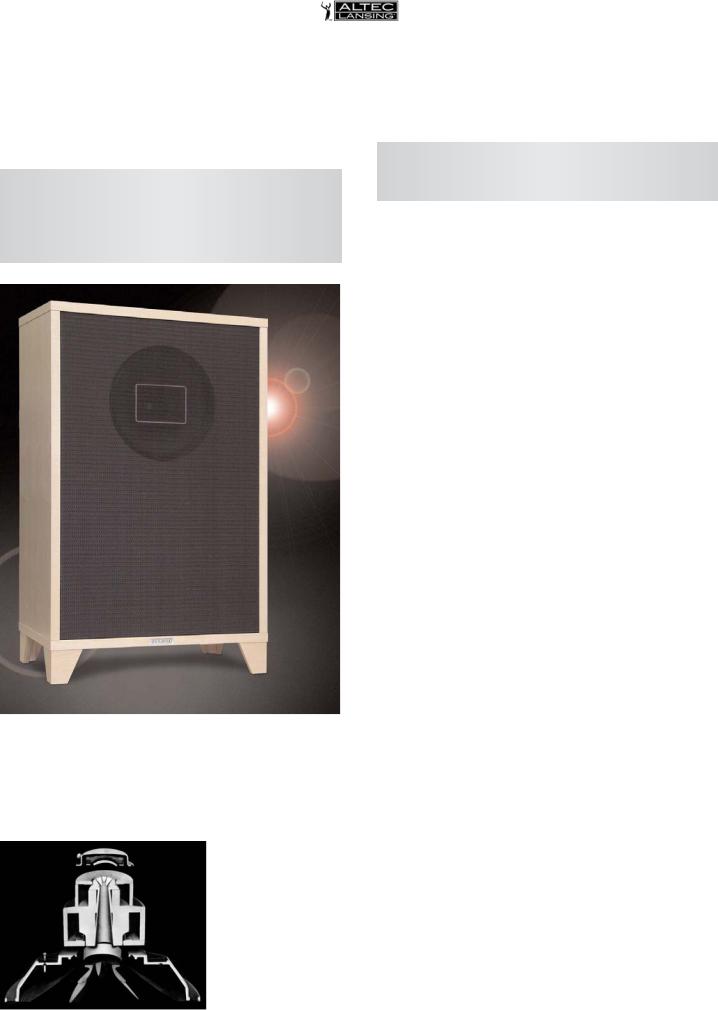Dynavox Imperial Brochure

Imperial |
|
|
|
Imperial |
|
Duplex powered by |
|
|
The legend lives on! |
Dynavox |
|
|
|
In 1943 the probably most famous speaker driver – the Altec Duplex 604 – was introduced by James B. Lansing. From 1943 until today this speaker remained the “standard” – state of the art – of professional monitoring speakers. 800+ recording and broadcast studios all over the world used and do still use the Altec 604 as their favorite monitoring speaker system.
„When my eyes were closed, the original performance was experienced as though it was not
an electromechanical reproduction“
A well known recording engineer about the Altec 604 Duplex
Dynavox Imperial
More than 60 years of production might give you a hint of the outstanding qualitites of this speaker system. There are a handful other speakers produced for such a long period (e.g. Tannoy, Lowther), but none is reputed a legend as the Altec 604.
Lansing´s design uses a 16 inch woofer with 3” voice coil in coaxial conjunction with a 1,75” compression tweeter driver, which in former times was designed as the socalled “Multicellular horn”. Todays improved version uses a
rectangular “Constant Directivity” Mantaray-Horn, named by its inventor Mantaray.
The Duplex design realizes a point source, which is undoubtedly the ideal of any speaker designer. Almost unintelligible that there are that few point source speakers available. After all todays Altec 604-L still is
much like the original design from the 1940s. Certain detail modifications and alterations make the “L”-version even sound better than some of the legendary predecessors.
Nothing is created any more.
What will be new, will be new through development
Friedrich von Schiller, famous German writer
The original Lansing crossover network design is a point of criticism. It does not match the speakers qualities. Designed to make the speaker work in many different enclosures the crossover design is a solution for all cases, a compromise.
Dynavox opted for an optimized crossover network to suit the Imperial horn enclosure perfectly. The Imperial´s crossover design outperforms the original by far. The Imperial´s crossover features 4 different settings to suit amplifiers of different character (tube or solid state)
Imperial´s enclosure is made from very rare “Ajous” wood, applied in a special 11-ply-sandwich-matrix. Typical “High End rules” like thick and heavy materials were abandoned. New ideas completely different to ordinary enclosure design were realized.
Dynavox scrutinized the influences of
•materials
•Wall thickness
•stiffing methods
•damping methods
and detected extreme sonical differences. The differences appeared to be far greater than anybody would ever have expected. Different prototype enclosures (same size, same speaker, but different material or different wall thikkness, different damping) sounded like completely different speakers.
Our research achieved astonishing results: Almost any of the “speaker-buil- der-rules” appeared to be not true. It might be surprising that e.g. an enclosure made from 1,2” (30mm) MDF (medium density fibreboard, a material commonly used) additionally stiffened and damped, sounded unprecise, dull and made the music sound almost entirely dead. You might ask why so many speaker designers do make their enclosures that way. To tell you the truth, MDF is an easy-to-machine material and it is quite cheap. On the other hand people seem to believe in certain “basic rules” which they never investigate again. We did!
If you take a closer look how speaker enclosures were made some decades ago you will mostly find materials like plywood or fibreboard.
What we – on first glance surprisingly - first found is that enclosures sounded the better the lighter their material was. High mass stores more energy than low mass. The widespread theory that more mass is less able to resonate, is simply wrong. High mass has high inertia as it calms down slowly. And that is how it sounds: sluggish, slow, lazy, dead.
Our research results made us search for a kind of wood especially light and stiff at the same time. Ajous is available as complete tree only. So we had to cut the panels ourselves. During the development of the Imperial we realized a double-wall-sandwich-matrix design with maximum stiffness at minimum weight.
Our Ajous-enclosure outperforms a traditional MDF-enclosure by far. One would not believe that the same speaker is playing.
Even if the production of the Ajous-enclosure is extremely costly, any effort is worth the result.
The enclosure works – like all Dynavox speakers – as a folded backloaded basshorn. All efforts result in the Dynavox Imperial, our ultimate speaker which is a true homage to James B. Lansing.
A final speaker.
